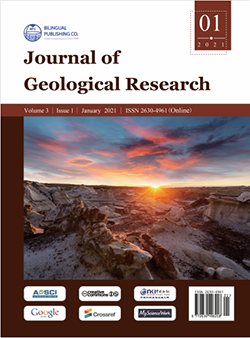Factor Analysis of the Parameters of Samples of the Steppe Soil and Grass Of Mongolia and Inland Mongolia of China on the Eastern Transsect of the Eurasian Steppe
DOI:
https://doi.org/10.30564/jgr.v3i1.2520Abstract
Regularities of rank distributions and binary relations between nine parameters are given. The most active are the geographical coordinates of 48 test sites. This proves that the geomorphology of the steppes in Mongolia and Inner Mongolia is becoming decisive. Factor analysis showed that the first four places for influencing variables and dependent indicators are the same:in the first place is the northern latitude, the second is the east longitude,the third is the average annual precipitation, and the fourth is the intensity of sheep grazing. The rest of the factors are located in different ways. The density of organic carbon was only in ninth place as an influencing variable,and in seventh place as a dependent indicator. This is based on the fact that organic carbon is an accumulative (cumulative) parameter over many years.The productivity of the biomass of steppe grass as an influencing variable is in sixth place, and as a dependent indicator (criterion) only in ninth place.This parameter is seasonal, therefore, in comparison with organic carbon, it is highly dynamic. The average annual temperature as an influencing variable is in fifth place,but as a dependent indicator only in eighth place. This was influenced by the strong averaging of the parameter (average value for the year). Plants are strongly influenced by the temperature dynamics during the growing season, and even more by the sum of temperatures during the growing season. With the productivity of steppe grass less than 75 g / m2 , the intensity of sheep grazing is zero. According to the second term of the trend, an optimum of 270 g / m2 appears with the maximum intensity of sheep grazing on average 65 pcs / km2 . The first fluctuation shows that with an increase in grass biomass, there is a loss of stability of the grass cover with an exponential growth of the amplitude. The second oscillation is dangerous in that with an increase in the biomass of the grass,the half-period of the oscillation sharply decreases and this will also lead to the collapse of the steppe grass. From the remnants of the effect of sheep grazing on grass biomass, it can be seen that there are three clusters: (1) from 0 to 30; (2) from 30 to 95; (3) more than 95 pcs / km2 . In this case, the variability of the productivity of the grass decreases.
Keywords:
Mongolia; Steppes; Soil; Grass; Parameters; Relationships; PatternsReferences
[1] Mazurkin P.M. Factor analysis of the subjects of the Russian Federation by shares of land.Scientific and practical journal “Natural resources of the Earth and environmental protection”, 2020, 1(6): 14-23. (in Russia) DOI: http://dx.doi.org/10.26787/nydha-2713-203X-2020-1-6-14-23.
[2] Mazurkin P.M., Mikhailova S.I. Distribution of plant mass in forest-meadow phytocenosis. Bulletin of the UMO on education in the field of environmental engineering and water use, 2011, 3: 330-340.(in Russia)
[3] Saati T. Decision-making. Hierarchy analysis method. M.: Radio and communication, 1993: 274.(in Russia)
[4] Torsuev N.P. Popular ecology (useful advice in everyday life). Kazan: Publishing house “Ecocenter”,1997: 236. (in Russia)
[5] Mazurkin P.M., Kudrjashova A.I. Factor analysis of annual global carbon dynamics (according to Global_Carbon_Budget_2017v1.3.xlsx). Materials of the International Conference “Research transfer”. Reports in English (part 2), Beijing, PRC., 2018: 192-224.
[6] Mazurkin P.M., Kudryashova A.I. Factor analysis of meteoparameters on the stage of growth of birch leaves. International Journal of Current Research.11(10): 7774-7779.
[7] Zhao Y., Ding Y., Hou X., Li F.Y., Han W., Yun X.Effects of temperature and grazing on soil organic carbon storage in grasslands along the Eurasian steppe eastern transect. PLoS ONE, 2017,12(10).DOI: https://doi.org/10.1371/journal.pone.0186980
Downloads
How to Cite
Issue
Article Type
License
Copyright © 2021 Peter M. Mazurkin

This is an open access article under the Creative Commons Attribution-NonCommercial 4.0 International (CC BY-NC 4.0) License.
Copyright and Licensing
The authors shall retain the copyright of their work but allow the Publisher to publish, copy, distribute, and convey the work.
Journal of Geological Research publishes accepted manuscripts under Creative Commons Attribution-NonCommercial 4.0 International License (CC BY-NC 4.0). Authors who submit their papers for publication by Journal of Geological Research agree to have the CC BY-NC 4.0 license applied to their work, and that anyone is allowed to reuse the article or part of it free of charge for non-commercial use. As long as you follow the license terms and original source is properly cited, anyone may copy, redistribute the material in any medium or format, remix, transform, and build upon the material.
License Policy for Reuse of Third-Party Materials
If a manuscript submitted to the journal contains the materials which are held in copyright by a third-party, authors are responsible for obtaining permissions from the copyright holder to reuse or republish any previously published figures, illustrations, charts, tables, photographs, and text excerpts, etc. When submitting a manuscript, official written proof of permission must be provided and clearly stated in the cover letter.
The editorial office of the journal has the right to reject/retract articles that reuse third-party materials without permission.
Journal Policies on Data Sharing
We encourage authors to share articles published in our journal to other data platforms, but only if it is noted that it has been published in this journal.




 Peter M. Mazurkin
Peter M. Mazurkin

